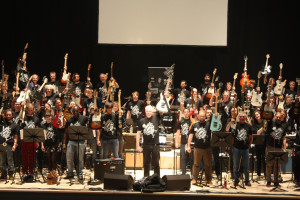Did New Yorker Rhys Chatham break a record for the number of guitarists found onstage at the Town Hall? Martin Longley thinks so…
Rhys Chatham
Birmingham Town Hall
When the guitarist/composer Rhys Chatham performs with his small combo, he’s usually clad casually, but in his role as conductor for this large-scale performance, he was suitably be-suited. There’s an immediate dichotomy here, when this New Yorker’s epic 2006 piece, A Secret Rose, was presented with the trappings of a classical work, but actually involved around 100 liberally-amplified electric guitars.
This was the UK premiere of the 75 minute, five-movement piece. Is this still rock’n’roll, harnessed by a score, yet still sounding somewhat unhinged? The closest musical comparison can be made with the work of Glenn Branca, with whom Chatham worked in 1978, although it’s not quite clear who influenced who, in the direction of guitar-stacked compositions. Chatham’s roots writhe right back to the beginnings of minimalist music, having studied under La Monte Young and Morton Subotnick in the late 1960s and early ’70s. He was the first music director of The Kitchen, the famed NYC art-space.
If you consider 100 electric guitars to be quite excessive, this is very restrained when set beside Chatham’s work for 400 axes. Not that your reviewer got into pedantic counting distraction, but an approximate scan suggested that the number of guitarists might have been more around the 75 mark.
Either way, the massed riffage was certainly sufficient in its propulsive weight. There looked to be around fifty amplifiers onstage, so there was a certain amount of sharing involved. The guitars were divided into three sub-sections, each directed by Chatham’s immediate sub-conductors, who appeared to be, in turn, responding to the composer’s ultimate pulse.
The drummer and bassist looked like they were directly in thrall to Chatham, loaded with the responsibility of driving this ungainly behemoth. Apart from being necessarily pushy, this rhythm duo were also alert to the funk, providing a supple springboard for the ebbing and flowing of collective guitar-thrang.
At first, axes were mostly stroked, creating a communal shimmer, but as the movements progressed there was a greater tendency to strum hard riffs, setting up a large ensemble incarnation of a Velvet Undeground-ish mesh-of-metal. Sonic Youth have clearly descended from Branca and Chatham, with Thurston Moore having worked with both composers, as a stripling.
A major object of A Secret Rose was the long-term courting of tension, the work’s length facilitating serial build-ups and releases. For most of the gig, Chatham’s own guitar and amplifier were left untouched, which gradually began to build up another kind of tension. When was he himself going to pick up and join the fray? Very close to the conclusion, he decided to do so, but it looked like he’d forgotten to turn on his amplifier.
After this brief snag, Chatham was soon adding to the construction, turning to face the audience. The sonic levels moved from subtle to overloaded, although there was a feeling of natural pile-up rather than artificial volume boosting. If matters became loud, this was because there were many voices, not because each amplifier was cranked up to 11.
A significant rush arrived during the climax of the third movement, where some of the players started pogo-ing, as if they were playing in a (relatively) tiny punk combo. A Mexican wave of machine heads took place, as if in homage to The Shadows. To follow, the piece settled back down into a slower exploration of hovering textures, but then rose up again for its final swell.
Even so, the preceding extremes of excitement weren’t revisited in full. There was much energy and ingenuity to bathe in here, but ultimately the knitting of the players and music didn’t quite connect at a totally optimum level. They got pretty darned close, though..!
Photos: Inès Elsa Dalal



